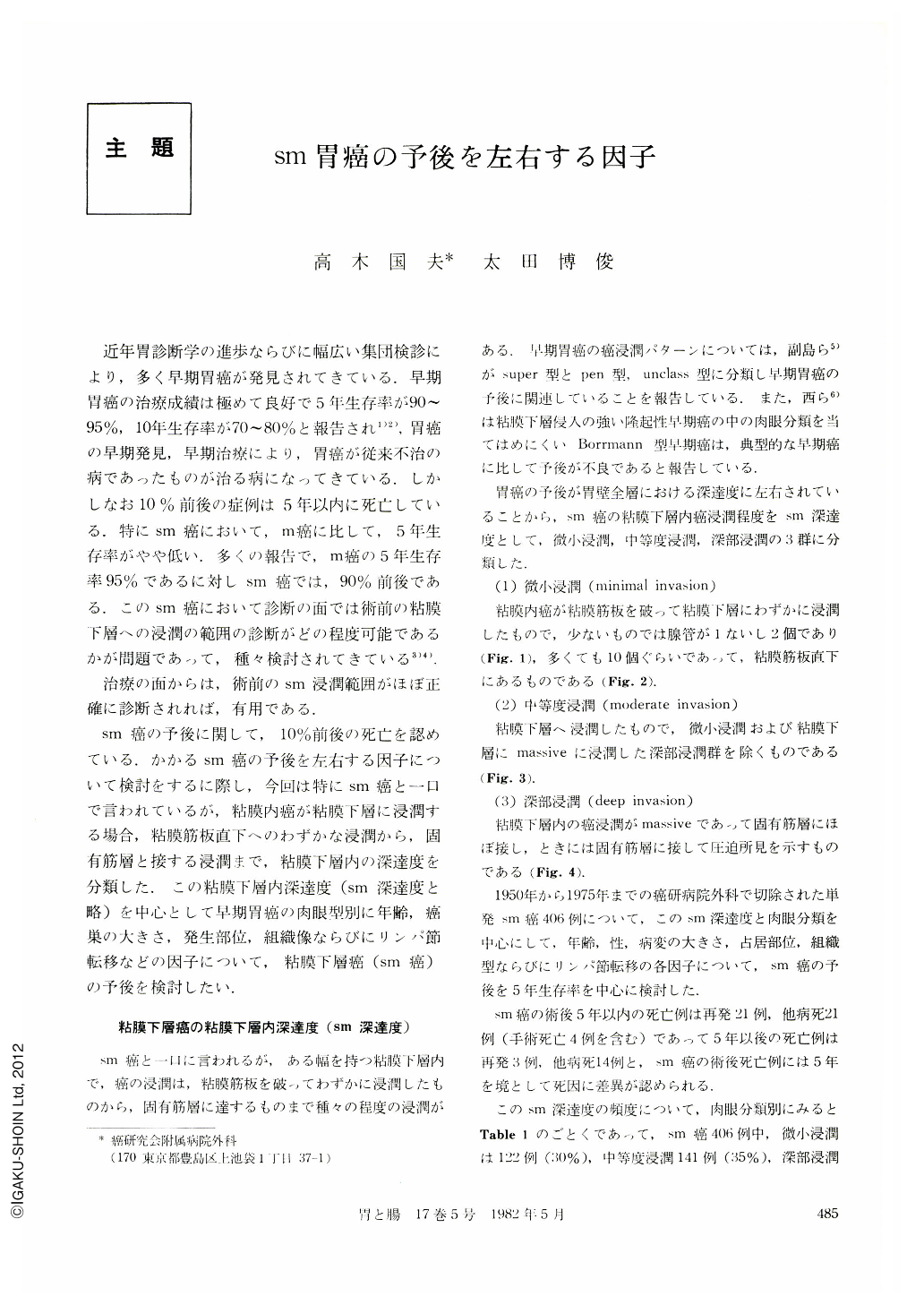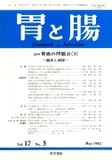Japanese
English
- 有料閲覧
- Abstract 文献概要
- 1ページ目 Look Inside
近年胃診断学の進歩ならびに幅広い集団検診により,多く早期胃癌が発見されてきている.早期胃癌の治療成績は極めて良好で5年生存率が90~95%,10年生存率が70~80%と報告され1)2),胃癌の早期発見,早期治療により,胃癌が従来不治の病であったものが治る病になってきている.しかしなお10%前後の症例は5年以内に死亡している.特にsm癌において,m癌に比して,5年生存率がやや低い.多くの報告で,m癌の5年生存率95%であるに対しsm癌では,90%前後である.このsm癌において診断の面では術前の粘膜下層への浸潤の範囲の診断がどの程度可能であるかが問題であって,種々検討されてきている3)4).
治療の面からは,術前のsm浸潤範囲がほぼ正確に診断されれば,有用である.
Analysing 406 cases of early gastric cancer with submucosal involvement, we investigated factors which may influence their prognosis.
We classified depth of Submucosal invasion into the following three types: 1) minute infiltrative type which has minute and partial submucosal invasion, 2) deep infiltrative type which has massive invasion almost adjacent to the proper muscle, and 3) moderate infiltrative type which is intermediate type and has invasion down to the mid-submucosal layer.
The incidence of the above three types was as follows: The minute infiltrative type was 30% (122/406), the moderate infiltrative type was 35% (141/406) and the deep infiltrative type was 35% (143/ 406), furthermore their five year-survival rate was 95, 94 and 80% respectively-suggesting the deep invasion has poor prognosis.
Relating the above microscopic classification to a macroscopic classification, we found that an incidence of deep submucosal invasion was more frequent in type Ⅰ and type Ⅱa+Ⅱc than other types of early gastric cancer, and their prognosis were also poor. We also investigated the prognosis of the following macroscopic types by analyzing the depth of their invasion, age, size of cancerous lesion, location, histological feature and lymph node metastasis. The results obtained were as follows: In type Ⅰ, recurrence due to liver metastasis was more frequently seen if the patient had deep submucosal invasion, larger lesion more than 4 cm and lymph node metastasis.
In type Ⅱa, it has been discussed together with type Ⅰ as protruded type of early gastric cancer, however, the type Ⅱa had different age distribution than type Ⅰ and furthermore the deep infiltrative type of the type Ⅱa had good prognosis. Therefore, type Ⅰ and type Ⅱa should be discussed separately.
In the type Ⅱa+Ⅱc, the deep submucosal infiltrative type with lymph node metastasis was found to have frequent recurrence and its prognosis was poor.
In type Ⅱc, less lymph node metastasis was noted in the minute infiltrative type but it was high as 26 in the deep infiltrative type and high peritoneal and local recurrence were noted.
In type Ⅱc+Ⅲ, the deep infiltrative type was less frequent than other types of early gastric cancer, but marked lymph node metastasis was seen in the minute infiltrative type as well as in the moderate infiltrative type and recurrence was noted in these types-showing some difference in the prognostic factors from the other type of early gastric cancer.
In type Ⅲ, cases were too small and further studies were required to be discussed.
It should be noted that patients who died more than five years after the operation for early gastric cancer had less recurrence and direct causes of their death were mainly due to other diseases. Therefore, necessity of postoperative long-term care was emphasized.

Copyright © 1982, Igaku-Shoin Ltd. All rights reserved.


